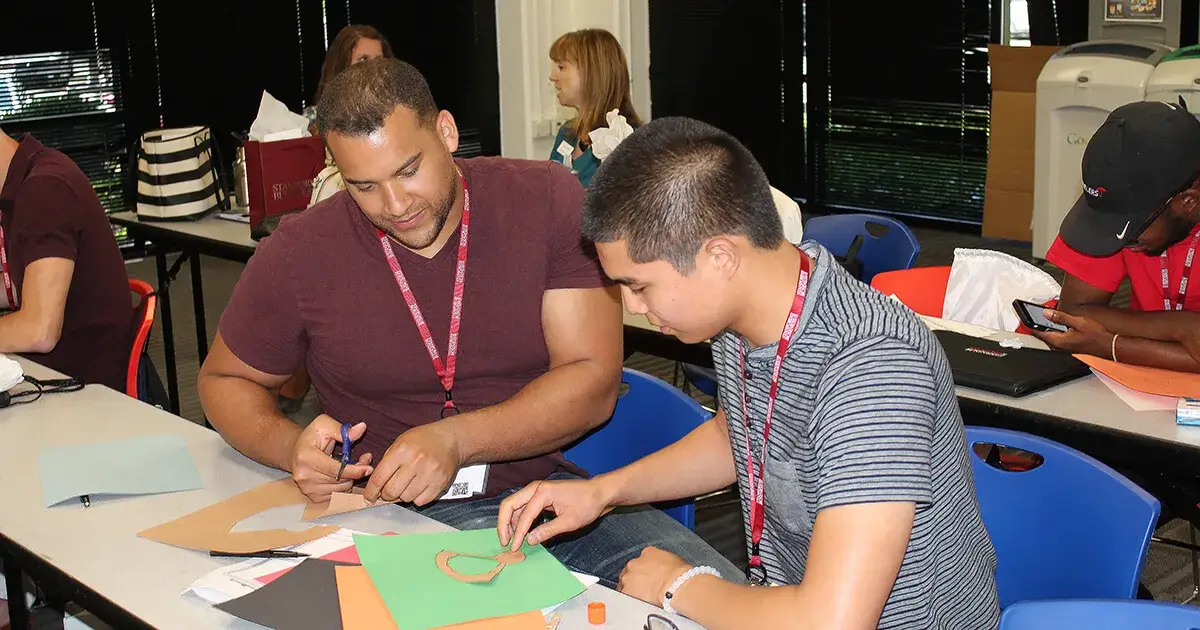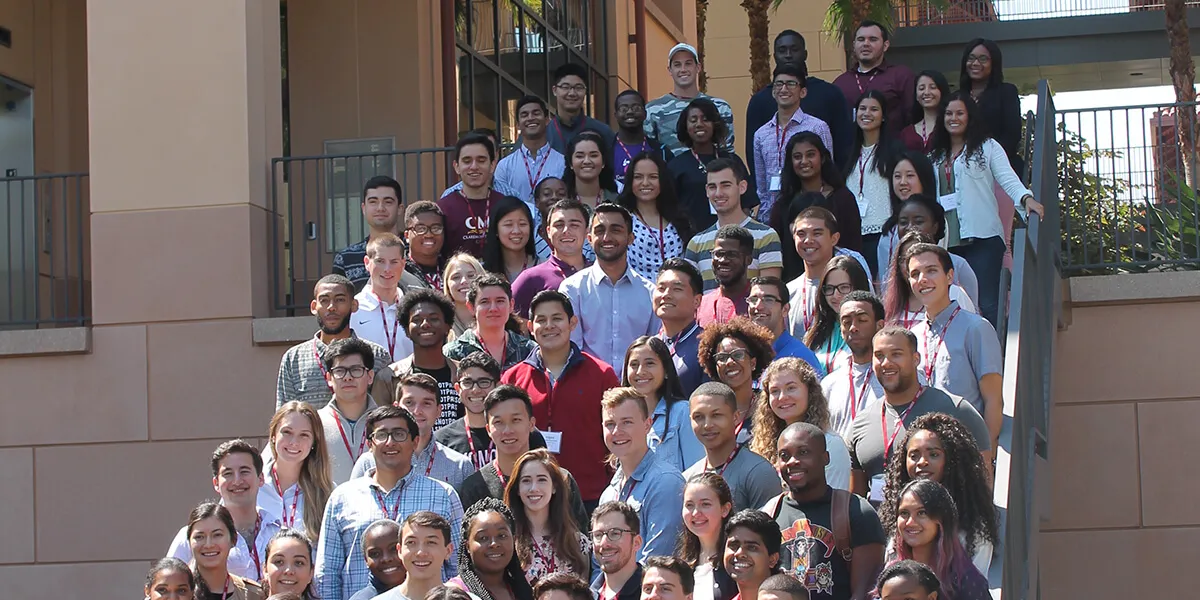At Stanford MBA Future Leaders Program, Potential Students from Diverse Backgrounds Get a Preview of Business School
Applications for the August 2017 program now open. Apply by Wednesday, March 1 2017, 5pm PST.
January 25, 2017

College students Gregory Knox (left) and David Giongco got a taste for design-thinking at the inaugural Stanford Future Leaders Program in August 2016. | Stanford MBA Admissions
Until recently, Karen Rodriguez-Ponciano, the daughter of Mexican farmworkers and a UC Berkeley undergraduate, hadn’t seriously considered an MBA. Hayden Choi, a first-generation Korean immigrant attending the College of William and Mary, aspired to an MBA but didn’t understand its value and had doubts he could compete in an elite program.
Rodriguez-Ponciano, Choi, and 81 other promising and diverse undergraduates from around the country found the answers to all their questions at the inaugural Stanford MBA Future Leaders Program, held last August at Stanford Graduate School of Business. The three-day residential program, designed to expose high-potential students to the MBA experience and help them understand what a good applicant looks like, opened with a cohort of students drawn from 56 universities in 25 states, all anxious to learn the benefits of an MBA and explore post-MBA career opportunities.
“I’m so elated for you to be the very first members of the Stanford MBA Future Leaders Program,” Simone Hill, MBA/MA ’14, Stanford MBA admissions officer, and the program’s staff director, told the group at a welcoming dinner. “This is a really special place, and I’m excited for all of you to experience it. This is about personal transformation: how you dream and innovate, the way you understand yourself and influence others, your sense of place in the world, and the lifelong relationships you form.”
Designed for college sophomores entering their junior year, the MBA Future Leaders Program aims to increase the breadth of backgrounds and perspectives represented in the business school by seeking out potential MBA students from diverse majors, including science, technology, engineering, math, and the humanities. Participants include African-American, Hispanic American, Native American, and LGBTQ students, along with first-generation college students, those who are Pell Grant-eligible, or those who have life and work experiences that may add a unique perspective.
A sign-in board on the program’s first evening asking students to describe themselves showed a range of responses including soldier, low-income, Navajo, non-religious, differently-abled, provider.
“I really want this to be a program where all students from diverse backgrounds see themselves here, and see themselves worthy of being here,” Hill said. “So many of the changes we make are guided by the access and exposure we have. How can we expect students who are the first in their family to go to college to know Stanford is the place for them if they’ve never experienced Stanford or know anyone who has experienced it?”
Over three days, students are exposed to Stanford GSB experience through a class immersion exercise, a hands-on design thinking event, a career design workshop, company visits to learn about career opportunities in a range of industries, and an MBA boot camp explaining the admissions process. Participants meet alumni, work with the career management center to brainstorm post-college plans, and experience a TALK presentation, a Stanford GSB tradition where a current student shares a personal story.
Midway through the program, students filed into a class immersion exercise in personal leadership led by Collins Dobbs, Stanford GSB instructor in organizational behavior. Over the course of the afternoon, the cohort learned and practiced communication techniques and strategies for giving and receiving feedback, before diving into a leadership case study.
“This is a little sample of what we teach the MBAs, the experiential aspect of leadership,” Dobbs said. “Given the nature of the world we live in, it requires all minds to be engaged … . One thing we believe is that leadership is developed; you’re always going to be leading different teams and doing so in different situations.
“Our hope is that this gives them something accessible that they can begin practicing right away,” he added. “I want them to leave with a little more confidence that they have some strength and the willingness to test it.” The diverse nature of the student group is exciting to watch, he said.
“As a faculty member I’m inspired with their level of creativity, their energy, and their innovation,” he said. “The perspectives they bring to the practice set may not be what our students think about.”
During a break in the class, student Hayden Choi, who is double-majoring in finance and Asian American Studies at the College of William and Mary, discussed how he worried he couldn’t compete in the Stanford GSB program.
“It’s feeling you just don’t belong. Am I being overshadowed by my peers? That’s how I felt on day one,” he recalled. “But I’ve begun to realize these people have accomplished amazing things, and you equally have this same potential. What really attracted me was being here with like-minded individuals and people who shared a similar background.
“After experiencing all this, you really get to see the benefits of putting yourself in an MBA student’s shoes, and see the skills you’ll gain,” he added. “This is all possible. Now we have a much clearer path.”

Participants in the 2016 Stanford Future Leaders Program | Stanford MBA Admissions
Karen Rodriguez-Ponciano majors in psychology and interdisciplinary studies at UC Berkeley, and previously gave little thought to an MBA.
“I’m the first in my family to go to college,” she said. “I come from a humble family of fieldworkers in Mexico. I wasn’t too sure of what an MBA would entail. But it was something I was curious about. I wanted to apply to this program to learn what an MBA program would feel like, to be exposed to it. Until recently, I didn’t even really know what business entailed.”
After experiencing the Future Leaders Program and meeting other potential MBA students, her perception has changed.
“I see a lot of common threads here – resilience, and determination to not only change the lives of ourselves and our communities, but to give back,” she said.
“It’s been life-changing and empowering. This is about enabling people to try something they’ve never thought about. You can’t be what you can’t see. This program has allowed me to see myself at Stanford GSB.”
—By Beth Jensen
For media inquiries, visit the Newsroom.
Explore More
Raj Tilwa, MBA ’24: Targeted Heating Systems to Help Cool the Planet

“Titan” of Accounting, William Beaver, Dies at Age 84

Stanford GSB Professor Susan Athey Receives the R.K. Cho Award
